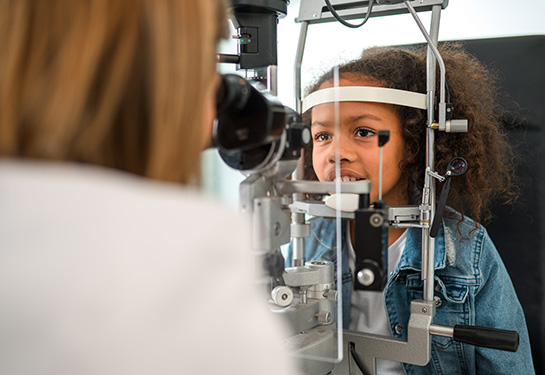Eye Center first to test microshunt in children with refractory childhood glaucoma
A polymer-based microshunt is safe and effective in pediatric patients with refractory childhood glaucoma, according to a small, single-center case series at the UC Davis Health Eye Center.
The study, Use of a Novel Microshunt in Refractory Childhood Glaucoma, was published in the American Journal of Ophthalmology. It includes a video showing the surgical technique of microshunt implantation in pediatric eyes.
“We are in a golden age of innovation for adult glaucoma. But treatments for children with glaucoma are largely an afterthought,” said James D. Brandt, lead investigator for the study. Brandt is a professor of ophthalmology and the Daryl and Opal Geweke Endowed Chair of Glaucoma at UC Davis Health. “No recently approved minimally invasive glaucoma devices have been systematically studied in children.”
In 2017, Brandt was an investigator for the adult clinical trial of PRESERFLO MicroShunt, under investigation in the United States and approved in Europe, Canada and Australia. The microshunt is fabricated from a polymer (SIBS [styrene-block-isobutylene-block-styrene]), which has a multidecade history of stability when used in coronary stents.
Brandt, an expert in childhood glaucoma, immediately saw its potential for children with refractory disease. He approached the Food and Drug Administration (FDA) about a study of the novel microshunt in children older than six months who had failed previous glaucoma surgery. He received FDA and Institutional Review Board (IRB) approval for a small cohort to receive treatment with the investigational device under the compassionate use pathway.
The case series included 12 eyes of children with refractory childhood glaucoma who needed trabeculectomy or implantation of a glaucoma drainage device. The age of the children ranged between 15 months and 14 years.
We are in a golden age of innovation for adult glaucoma. But treatments for children with glaucoma are largely an afterthought.” —James D. Brandt
Before their operation, the patients were, on average, on 3.3 medications and had an intraocular pressure of 22.72 mm Hg. The surgical team modified the adult investigational device exemption protocol. They performed general anesthesia, a smaller limbal incision in the superior-nasal quadrant of the affected eye, and precision injection of 40 µg of mitomycin-C in the superior-nasal quadrant rather than the use of sponges.
The team noted no complications during the operation. They found that the flow of the aqueous humor from the posterior lumen of the device happened immediately upon entry of the device into the anterior chamber; little, if any, aqueous humor flows around the device.
Results
The team followed these children for at least one year after their operation. At 12- to 18-month follow-ups, nine eyes (75%) showed success. Three eyes (25%) failed and required additional surgery.
After one year, the nine successful eyes had a 45% drop in their intraocular pressure (from 21.6 ± 4.9 mm Hg pre-operation to 11.9 ± 3.8 mm Hg). Also, seven patients were taking no medications, and two required two medications (fixed-combination dorzolamide-timolol).
Although promising, Brandt notes there are significant limitations to the study. It was too small and heterogeneous — in terms of age, diagnosis, and previous surgery — to generalize to all children. And one of the more common forms of childhood glaucoma, glaucoma after cataract surgery, was not encountered in this initial cohort.
Also of note was that preoperative intraocular pressure in the success and failure groups overlapped. The data are too sparse to evaluate the role of starting intraocular pressure in long-term outcomes.
Learning to place microshunts in pediatric eyes
Brandt had experience placing the microshunt in adult eyes, but he observed a significant learning curve when performing the procedure in pediatric eyes.
“The device is designed for an entry site 3 mm posterior to the limbus to assure proper scleral seating of the microshunt and a short 1.5 mm length of the implant in the anterior chamber. The limbus can be challenging to identify in children, particularly in eyes with significant buphthalmos, or anterior segment dysgenesis where limbal landmarks are smeared or indistinct,” Brandt said.
Bleb-forming minimally invasive glaucoma surgery (MIGS) devices might be an attractive interim step for refractory childhood glaucoma before moving to the more extensive surgical dissection and risk associated with trabeculectomy with mitomycin-C or plate-based glaucoma drainage devices.
The team is planning a multicenter, prospective clinical trial of this novel microshunt. It will be the first clinical trial of the device in children.
Read the study.
The UC Davis Eye Center
The UC Davis Eye Center provides world-class eye care, pioneers collaborative vision research, and trains the next generation of specialists and investigators to become leaders in the Sacramento region and beyond. The Eye Center team aims to transform vision care and develop cures for blinding eye diseases, from cornea to cortex.






